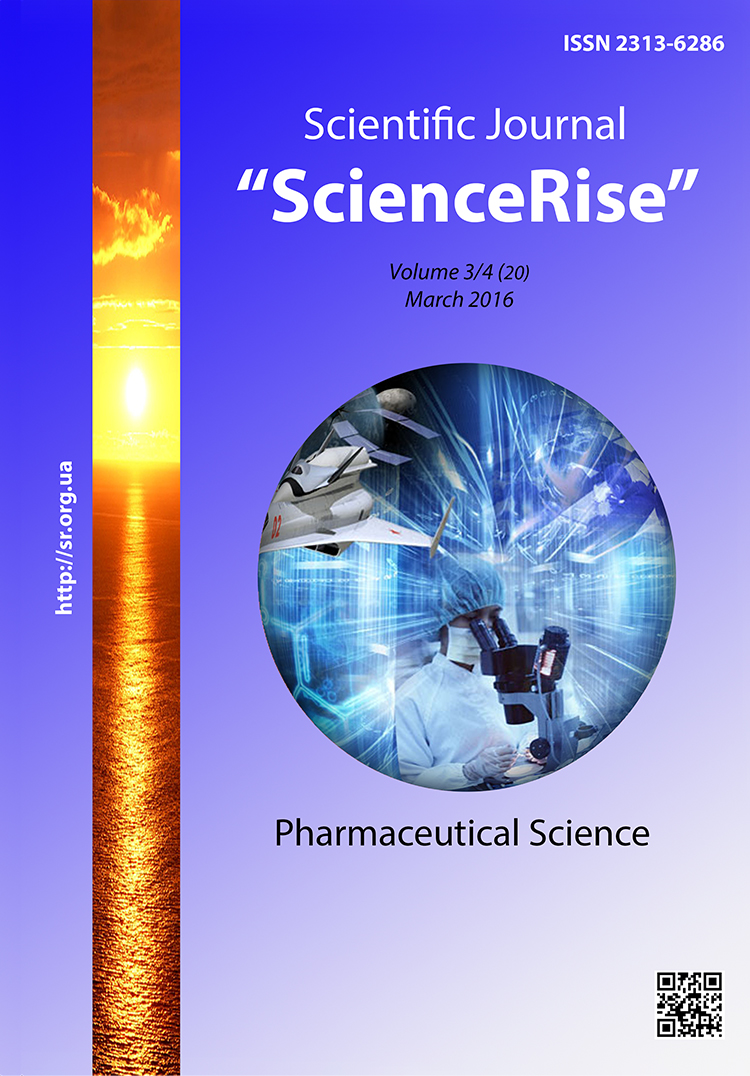Development and validation of the «dissolution» test for riboxine tablets
DOI:
https://doi.org/10.15587/2313-8416.2016.64504Keywords:
Riboxine, dissolution, UV-Vis absorption spectroscopy, tabletsAbstract
Under conditions of the pharmaceutical industry intensive development and variety of oral drugs, the improvement of specialists’ knowledge about remedies of this category and processes taking place in human’s organism at their absorption remains relevant. To increase the bioavailability of drugs and to reduce adverse pharmacological effects, the dissolution test has been implemented for tablet dosage forms.
Aim. The aim of our research was to develop and to validate the dissolution test methods for tablets, containing Riboxine as an active ingredient, which has metabolic, antihypoxic and antiarrhythmic effect, and recently is produced by Ukrainian pharmaceutical manufacturers.
Methods. The dissolution test was carried out using ERWEKA DT 806 HH instrument for determination of tablets solubility. Analytical research were carried out by the absorption spectroscopy method using Specord 205 («Analytik Jena AG», Germany) spectrometer with the use of OHAUS AP 250D («Ohaus Corporation», USA) electronic laboratory scales and type A laboratory glassware.
Results. As a result of research, the dissolution agent (water), its volume, the active ingredient concentration, and the time of the test (45 minutes) has been chosen. It was suggested to determine the amount of Riboxine passed into the solution by the method of UV-Vis absorption spectroscopy at wavelength 249 nm using standard method.
Validation parameters according to the SPhU requirements, i.e. specificity, linearity, precision (convergence), accuracy, and range of application were studied. It was determined that validation parameters of the method didn’t exceed the critical error (3,0 %).
Conclusion. In result of performed experimental research the spectroscopy method for Riboxine quantitative determination after pharmaco-technological dissolution tests was developed and validated. Dissolution agent, its volume, dissolution time and the amount of tablets for determination was suggested
References
Peart, J., Flood, A., Linden, J., Matherne, G. P., Headrick, J. P. (2002). Adenosine-Mediated Cardioprotection in Ischemic-Reperfused Mouse Heart. Journal of Cardiovascular Pharmacology, 39 (1), 117–129. doi: 10.1097/00005344-200201000-00013
Peart, J., Willems, L., Headrick, J. P. (2002). Receptor and non-receptor-dependent mechanisms of cardioprotection with adenosine. American Journal of Physiology – Heart and Circulatory Physiology, 284 (2), H519–H527. doi: 10.1152/ajpheart.00717.2002
Peart, J. N., Gross, G. J. (2003). Adenosine and opioid receptor-mediated cardioprotection in the rat: evidence for cross-talk between receptors. American Journal of Physiology – Heart and Circulatory Physiology, 285 (1), H81–H89. doi: 10.1152/ajpheart.00985.2002
Kursov, S. V., Nikonov, V. V., Hyzhnjak, A. A. et. al (2013). Osoblyvosti gemodynamichnyh efektiv inozytu (korotkyj literaturnyj ogljad za rezul'tatamy vlasnyh sposterezhen'. Medycyna neotlozhnыh sostojanyj, 1 (48), 86–92.
Dachir, S., Shabashov, D., Trembovler, V., Alexandrovich, A. G., Benowitz, L. I., Shohami, E. (2014). Inosine improves functional recovery after experimental traumatic brain injury. Brain Research, 1555, 78–88. doi: 10.1016/j.brainres.2014.01.044
Zai, L., Ferrari, C., Dice, C., Subbaiah, S., Havton, L. A., Coppola, G. et. al (2011). Inosine Augments the Effects of a Nogo Receptor Blocker and of Environmental Enrichment to Restore Skilled Forelimb Use after Stroke. Journal of Neuroscience, 31 (16), 5977–5988. doi: 10.1523/jneurosci.4498-10.2011
Derzhavna Farmakopeja Ukrai'ny. Vol. 1 (2015). Kharkiv: Derzhavne pidpryjemstvo «Ukrai'ns'kyj naukovyj farmakopejnyj centr jakosti likars'kyh zasobiv», 1128.
Kitajs'ka farmakopeja. Vol. 2 (2005). People's Medical Publishing House, 438–440.
Gosudarstvennaja farmakopeja Rossijskoj Federacii. Chep. 1 (2007). Nauchnyj centr jekspertizy sredstv medicinskogo primenenija. RIBOKSIN (FS 42-0275-07), 624–627.
Chitta, R., Pendela, M., Yekkala, R., Herijgers, P., Hoogmartens, J., Adams, E. (2010). Determination of Adenosine and Inosine in Sheep Plasma Using Solid Phase Extraction Followed by Liquid Chromatography with UV Detection. Analytical Letters, 43 (14), 2267–2274. doi: 10.1080/00032711003717323
Rosada, M. V., Bevz, N. Ju., Georgijanc, V. A. (2015). Rozrobka ta validacija metodyky kil'kisnogo vyznachennja ryboksynu v tabletkah. Upravlinnja, ekonomika ta zabezpechennja jakosti v farmacii', 5 (43), 21–26.
Rosada, M. V., Bevz, N. Yu., Garna, N. V., Georgiyants, V. A. (2016). The study of dissolution kinetics of drugs with riboxinum (inosine). Der Pharma Chemica., 8 (1), 412–416. Available at: http://derpharmachemica.com/vol8-iss1/DPC-2016-8-1-412-416.pdf
Downloads
Published
Issue
Section
License
Copyright (c) 2016 Микола Володимирович Росада, Наталія Юріївна Бевз, Вікторія Акопівна Георгіянц

This work is licensed under a Creative Commons Attribution 4.0 International License.
Our journal abides by the Creative Commons CC BY copyright rights and permissions for open access journals.
Authors, who are published in this journal, agree to the following conditions:
1. The authors reserve the right to authorship of the work and pass the first publication right of this work to the journal under the terms of a Creative Commons CC BY, which allows others to freely distribute the published research with the obligatory reference to the authors of the original work and the first publication of the work in this journal.
2. The authors have the right to conclude separate supplement agreements that relate to non-exclusive work distribution in the form in which it has been published by the journal (for example, to upload the work to the online storage of the journal or publish it as part of a monograph), provided that the reference to the first publication of the work in this journal is included.

